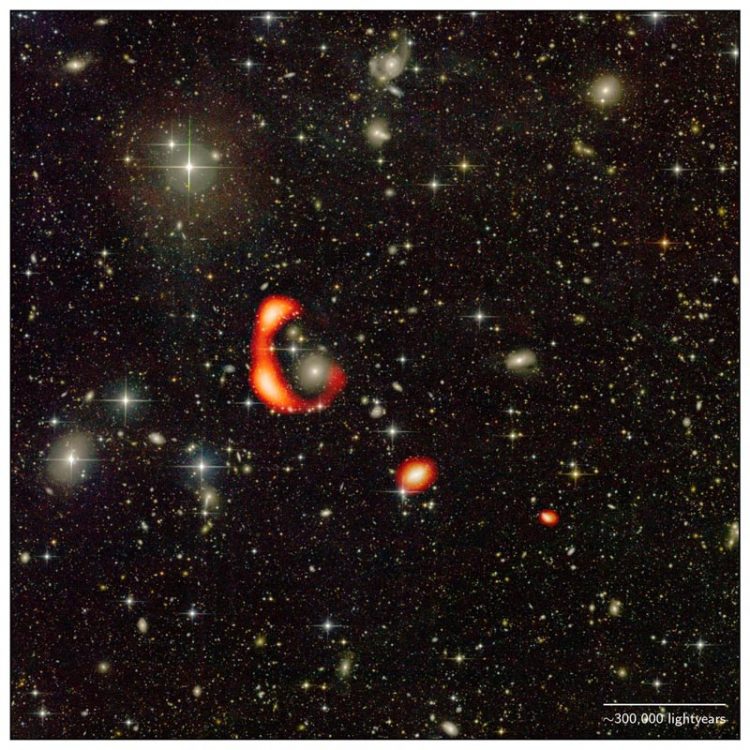GMRT discovers a gigantic ring of hydrogen gas around a distant galaxy

The optical image from the CFHT telescope with the distribution of neutral hydrogen in the form of a large ring shown in red as observed by the GMRT. The other two red blobs show the distribution of neutral hydrogen around two other galaxies which are in the vicinity of the ring. Credit: O. Bait (NCRA-TIFR/GMRT), Duc (ObAS/CFHT)
The galaxy (named AGC 203001), is located about 260 million light-years away from us. There is only one other such known system with such a large neutral hydrogen ring. The origin and formation of such rings is still a matter of debate among astrophysicists.
Neutral hydrogen emits radio waves at a wavelength of about 21cm. This radiation from neutral hydrogen atoms has allowed radio astronomers to map the amount and distribution of neutral hydrogen gas in our Milky Way galaxy and in other galaxies in the Universe.
Typically, large reservoirs of neutral hydrogen gas are found in galaxies which are actively forming new stars. However, despite showing no signs of active star formation the galaxy AGC 203001 was known to have large amounts of hydrogen, although its exact distribution was not known.
The unusual nature of this galaxy motivated astronomers in NCRA to use the GMRT to conduct high-resolution radio observation of this galaxy to find out where in the galaxy this gas lies.
The GMRT observations revealed that the neutral hydrogen is distributed in the form of a large off-centered ring extending much beyond the optical extent of this galaxy. More puzzlingly, the astronomers found that the existing optical images of the ring showed no sign of it containing stars.
In collaboration with two French astronomers, Pierre-Alain Duc and Jean-Charles Cuillandre, the NCRA team obtained a very sensitive optical image of this system using the Canada-France-Hawaii-Telescope (CFHT) in Hawaii, USA. However, even these images do not show any sign of starlight associated with the hydrogen ring.
There is no clear answer today as to what could lead to the formation of such large, starless rings of hydrogen. Conventionally, galaxy-galaxy collisions were thought to lead to the formation of such off-centered rings around galaxies.
However, such rings also generally contain stars. This is contrary to what is found in this ring. Figuring out how this ring was formed remains a challenge to astronomers.
Encouraged by this discovery, the team is now conducting a large survey to map the neutral hydrogen around several more similar galaxies. If some of them also show rings like this, it should help us to better understand the formation mechanism behind such rare rings.
This work was led by Omkar Bait, a doctoral student at NCRA working under the supervision of Yogesh Wadadekar. This work forms a part of Omkar's doctoral thesis. Sushma Kurapati, who is another doctoral student at NCRA also played a role in the radio observations.
Other expert scientists who contributed include, Pierre-Alain Duc (Universite de Strasbourg, Strasbourg, France), Jean-Charles Cuillandre (PSL University, Paris, France), Peter Kamphuis (Ruhr University, Bochum, Germany) and Sudhanshu Barway (Indian Institute of Astrophysics, Bengaluru, India).
###
(Acknowledgments: GMRT is run by the National Centre for Radio Astrophysics of the Tata Institute of Fundamental Research. Based on observations obtained with MegaPrime/MegaCam, a joint project of CFHT and CEA/DAPNIA, at the Canada-France-Hawaii Telescope (CFHT) which is operated by the National Research Council (NRC) of Canada, the Institut National des Sciences de l'Univers of the Centre National de la Recherche Scientifique of France, and the University of Hawaii.)
Media Contact
More Information:
http://dx.doi.org/10.1093/mnras/stz2972All latest news from the category: Physics and Astronomy
This area deals with the fundamental laws and building blocks of nature and how they interact, the properties and the behavior of matter, and research into space and time and their structures.
innovations-report provides in-depth reports and articles on subjects such as astrophysics, laser technologies, nuclear, quantum, particle and solid-state physics, nanotechnologies, planetary research and findings (Mars, Venus) and developments related to the Hubble Telescope.
Newest articles

Machine learning algorithm reveals long-theorized glass phase in crystal
Scientists have found evidence of an elusive, glassy phase of matter that emerges when a crystal’s perfect internal pattern is disrupted. X-ray technology and machine learning converge to shed light…

Mapping plant functional diversity from space
HKU ecologists revolutionize ecosystem monitoring with novel field-satellite integration. An international team of researchers, led by Professor Jin WU from the School of Biological Sciences at The University of Hong…

Inverters with constant full load capability
…enable an increase in the performance of electric drives. Overheating components significantly limit the performance of drivetrains in electric vehicles. Inverters in particular are subject to a high thermal load,…





















